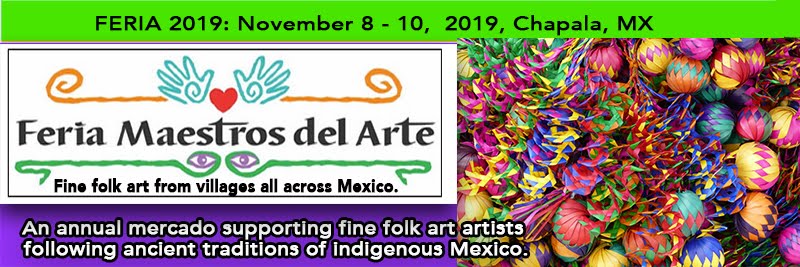Update: If you haven't had a chance to see this amazing show, the date has been extended to April 28. Here is a short video which will give you a sense of it. Linda Hanna, organizer of the show, reports that it will travel to Coyoacán in November, 2019. We will give you details of that show when available.
 |
| Click here to view video of the show |
More about the show:
 |
Artist: Pascuala Vásquez Hernández
Zinacantán, Chiapas. |
 |
Artist: Faustina Sumana García
San Juan Chilateca, Oaxaca. |
Linda explains, "I first became aware of the Virgin of Guadalupe during a trip to Mexico that my family took in 1959. I watched as the devout approached the Basilica on their bandaged and sometimes bloody knees. This made a big impression on me at the age of thirteen, even though I was not Catholic."
The reverence for Guadalupe, fascinated Linda and she began to study the Virgin’s history starting with the miracle of her revelation on the cloak of Juan Diego, a local indigenous man, to the banner made in 1810 by the priest Miguel Hidalgo y Costilla, featuring the Virgin in an effort to unite the people of Mexico in a struggle for independence, to her ever-present image throughout Mexico.
 |
Artist: Margarita Avendaño Luis
Pinotepa de Don Luis, Oaxaca. |
Seeing women coming together to make art honoring the Virgin gave Linda the idea for creating a Virgin of Guadalupe exhibit featuring clothing made by individual, textile artists from various regions of Mexico and representing many different techniques. Because Linda knows so many textile artists she was able to pull together work from ten states of Mexico: Oaxaca, Chiapas, Colima, Guerrero, Jalisco, Mexico (State), Michoacán, Puebla, Tlaxcala and Yucatán. The exhibit includes not only clothing, but also accessories, such as bags, shawls and jewelry, items worn close to the heart.
 |
Artist: Hever Martínez Velasco
San Pedro Cajonos, Oaxaca. |
Linda describes how the artists have responded to being included in this project:
"In many conversations I had with the artists, I was moved by their sincere enthusiasm and the honor they felt at being given the opportunity to depict the Virgin. One artist even went to his church to have his thread blessed and to pray for guidance in capturing the beauty of his muse.
 |
Artist: Gildardo Hernández Quero
San Pablo Villa de Mitla, Oaxaca. |
 |
Artist: Enriqueta Cenobio Calixto
San Felipe Santiago, Estado de México. |
-- Linda Hanna has been an avid supporter of local folk art since she first moved to Oaxaca in 1997. Prior to that, she spent fifteen years working as a fiber artist and therefore has profound appreciation for the textile traditions and talent found in many Oaxacan communities. For the past 14 years she has acted as coordinator for the Oaxacan artists who participate in the annual craft show Feria Maestros del Arte. She operates a Bed & Breakfast out of her home: www.folkartfantasy.com





